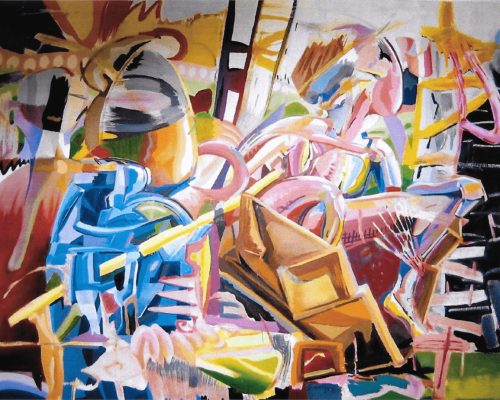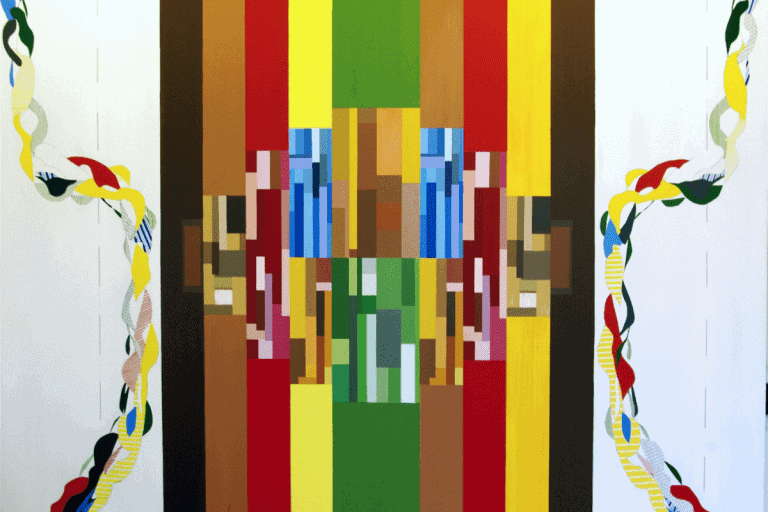MULTI-SYSTEMS AND THE MULTIPLEX EXHIBITION
Andy Cline, M.F.A.
Western Carolina University (August 2007)
Director: Robert Godfrey
ABSTRACT
I propose in this thesis that diverse means in art practice and aesthetics have replaced monolithic exhibition values. Process and concept have gained an equal footing with traditional art practices in the contemporary world. The presence of varied works in varied media is historically and aesthetically appropriate at this time. The interest here in this thesis is how the sum total effect of systems results in a creative ecosystem, defined liberally as relational art. The existence of heterogeneous, dissimilar art objects becomes the evidence of diverse culture and cultural exchange.
A blend of methods and materials, an ecology of relationships, are offered in this exhibition that refers to the interface between humanness/biology and the mechanical/technological world, underscoring the tandem development of each, largely by way of abstraction. This binary is part of the work, but also the exhibition strives to move beyond this closed circuit reasoning. The relationship between processes and forms itself becomes the subject, downplaying the notion of binaries and conflict. Though each system is separate according to its nature, all systems have developed progressively from studio practice, creating an environment of discursive interference in the exhibition hall.
INTRODUCTION
The title of this thesis originated from a need to recognize and act on the theoretical and aesthetic concerns of present-day art, and more broadly, of present-day cultural experience, which is of course as diverse as the internet or as available as ethnic food in your local neighborhood market.
Multi-systems, a term I use as a way to signify a diverse array of signs, processes, and materials in a gallery space, have grown out of studio development and inquiry into the significance of making art. Nicolas Bourriaud recognized that the artist has become an engineer in the trajectory of signs. And even earlier, Roland Barthes foreshadowed this idea:
There are a plurality and a coexistence of lexicons in the same person; the number and identity of these lexicons form in a sense each person’s idiolect. The image, in its connotation, would thus be constituted by an architecture of signs drawn from a variable depth of lexicons…
Different media and different materials carry different significations and it is out of expediency and de-mystification that I employ varied disciplines within the arts, but it is also a deep motivation to move against homogeneity that I’m compelled to look at the exhibition space as a laboratory in which to model an ecology of meaning.
The works: painting, mechanical sculpture, interactive video, drawing, text, are an attempt to create heterogeneous space in which parties (represented by art objects as well as by individuals in the room) communicate across borders (media) and boundaries (behavioral conventions for public space.). Works, art objects, considered in this way, as growths from cognitive networks of meaning, are reconciled one to another by their membership to the network of ideas and are in a relationship despite their differences. The audience is invited to become a part of the exhibition and thus a part of that relationship.
In my work and in this thesis, there is a personal idiolect of human and technological motifs and suggestions of mutation and trading of identity. The environment is watching the audience as the audience is watching the environment. The exhibition is about discursive relationships and the interface between binary groups in the context of a larger world depicted primarily in abstract form.
A WORD ON POSTMODERNITY
A negative result of postmodernity, the end of this or that ideology, art, or social class; (the “crisis” of Leninism, social democracy, or the welfare state, etc., etc.)” and the vacuum, saturation, and homogenization that postmodernism affected leaves history in a state of pulverized entropy. This pulverized ground is what present day art stands on.
The transition to postmodernism and the ashes that it left behind has become fertile ground for the rising up of new beyonds. Perhaps this explains the trends in contemporary art involving mapping of spaces, both physical and psycho/social, evident in works as diverse as Matthew Ritchie and Maurice Benayoun. Perhaps it also explains the diversity of integrated media practices and the popularity of installation, interactive art, video, in situ and site-specific work, and endurance art to list a few genres that fall outside the purview of more traditional art media. Tristan Tzara’s “anti-art”, as well as Duchamp’s have established roots firmly in the art institution.
The way in which artists and curators regard the exhibition and the exhibition space needs to change as society’s expectations of it changes if there is to be hope that the institution of fine art will continue to play a vital and proactive role in the organization and development of culture at large into the future, that is to say, a role that supersedes art’s most dominant form today, that of simple commodity and means to signify status and power.
Great works of art may transcend the political quibbles associated with theory and movements, but as we live in an era that is commonly thought of as “saturated”, a time when the effects of modern image making; reproduction, photography, video, and film, have inundated visual culture with every variety of high and low art blended together, there comes a time to face up to the situation: Camelot has finally fallen.
Now we need more than the heroic artist. We need heroic new self-governing worlds.
Early bedfellow of post-modern theory, conceptual art has filtered through its fixed place in history, specifically, the mid-60s to the mid-70s and increasingly manifests itself in new ways in works by many artists who have integrated the historical matrix of conceptual concerns.
The difference today is an increased blurring of object and subject. In historical conceptual works, much of what was displayed was an archive. It was the archive that became the object, leaving the actual experiences or creative processes as the subject.
But artists now are creating conditions in which the object and subject are one and the same by finding ways to employ their audiences, involve them, and allow them to interact with the machinery of the exhibition space.
The relational art narrative when it comes to artists is self-negating and radically communalistic. The vision is that artists and curators have moved into a brave new world in which authoritarian walls in the art world are being actively and deliberately de-centralized. Claire Bishop and others would make strong, compelling arguments to the contrary, that the artist is being de-throned by superstar curators.
Although mighty power controls such events, the proliferation of major biennials and art fairs are an outgrowth of this decentralization. High speed and global communication have changed all possibilities.

The image above is an example of the kind of preliminary drawings that are so easily executed and communicated rapidly, thanks to the internet and design/cad software. The virtual nature of the internet encourages a conceptual approach to planning.
META-CONCEPTS: HUMAN CONSIDERATIONS
A. Bourriaud’s theory of Relational Aesthetics is an “aesthetic theory consisting of judging artworks on the basis of the inter-human relations which they represent, produce and prompt.“
Bourriaud coined the term and organized a philosophy around the phenomenon, but artists at least as early as the 60’s were making works that could be critiqued on these grounds.
This more contemporary concept of relational art is descendent of conceptual art but in this case, the form has expanded to include more considerations about involving the public. The artist no longer seeks to claim hermetic creative domain. Art has been placed on a horizontal plane and made inclusive by these artists, curators, critics, and theorists (who are often one and the same).
The idea of an audience experiencing work actively, escaping the captivity of the heroic artist’s object making is interesting and important. Strategies to democratize contemporary art are exciting to me.
I set out to integrate interactive work into my exhibitions, not exclusively, but as an element among elements.
Permeability is the hallmark of heterogeneous, ecologically diverse communities and to that end, I intend to develop ideas that include audience interaction in the life of the exhibition space. A dynamic, multi-media art space can help to awaken visitors to new possibilities because it complicates learned behaviors about how to move through these public environments. A conceptual tradition, that of archiving works and processes and presenting the results is a more didactic approach for communicating about a community happening that took place. The evidence of the happening becomes the art in the show space. Seeding Survivors is such a project.
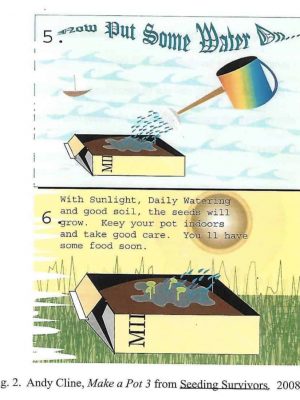
B. Integrated Arts: The strategy of using diverse materials and messages to convey a panel of ideas is elementary and political. Some ideas are more well suited for conveyance by certain means/objects than others.
Breathing, the actual act of breathing, a worthy subject, seems better represented by time-based works than by static ones. It is an experimental struggle, possibly a fruitless one to convey breath in painting. The style and rhythm of a painting might come close to syncopating breath, in the way Charles Olsen attempted with poetry to gather and project the vital force of breath in every passage.
But poetry is time-based and vocal and lends itself to the reproduction of breath. Sargent breathed life into portraits, but I don’t believe he was able to breathe breath into them. So I make something that fits the role, a mechanical sculpture that can do the job more naturally than any imitator in paint or line.
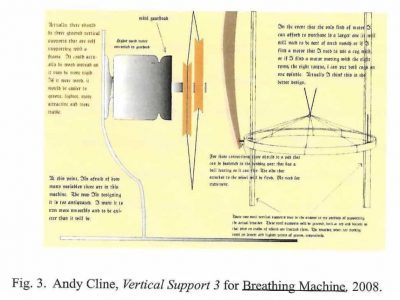
The political dimension of integrated arts then is its leveling of the status and privilege of traditional means and materials in the arts, it’s rejection of homogeneous culture and, positively, its tendency to model a diverse communal culture of materials and ideas. It denies the primacy of the plastic arts per se, and instead focuses on and uplifts a hierarchy of ideas and seeks appropriate forms to bring about effective communication.
And though, through the use of diverse materials, there is a priority placed on the role of ideas over or in front of the objet d’art, an evaluation of form remains the only means to judge the aesthetic and communicative value of works, and even use value.
Ultimately visual art must be sensed and people will respond to its physicality. Its physical presence needs to communicate in some way and to effect a connection between the viewers and the works/environment.
Integrated arts offer more of the visual and tactile textures that exist out there in the world. There’s the simulacra, the actions of the automaton, (video) the landscape in the play of light and shadow on the sculptural object, and then the immortal pause (painting). This is the rhythm I’m interested in exploring.
There are a richness and variety that, while confusing what has been expected in the gallery, also brings an exhibition down to earth and focuses the viewer towards an experience of being immersed inside a specific kind of life, as if the gallery space and the exhibition are actually the innards of some life form (Olaffur Elliason), or the insides of a machine or a computer (Michael Asher), a living entity. The contrast of different media imposes itself on the audience by stimulating multiple senses.
When integrated, experiential artworks can have an imposing effect. Thomas Hirschhorn, who makes elaborate found object 2d and 3d works, described his fascination with collage, a historical precursor to integrated arts, in an interview with Alison M. Gingeras:
I always liked making collages. I liked bringing together what shouldn’t be brought together. The stronger the contrast, the better it was… As students, we were always encouraged to go beyond the Rolls Royce juxtaposed with the hungry Third World child. It took me a long time to understand that the really important thing was the Rolls Royce juxtaposed with the hungry Third World child! – Thomas Hirschhorn
This regard for art as a cognitive event, evidenced in the case of collage by the critical orientation of opposing visual ideas, and as a vehicle for philosophical development in contrast to the purely aesthetic experience is what Tzara and most notably, Duchamp were after in their efforts to undermine the quasi-religious aura” envisioned to replace the spiritualist ideas of pure painters (Cezanne) and sculptors (Rodin).
Where the realization of form was tantamount to the sublime, Duchamp carved out a new path that embraced art as thought, not form and unlocked an ocean of next-generation artistic development. History is full of measures and counter-measures. A degree of the contemporary impulse can be counted as reflexivity, leaving space for the sublime to co-exist with concept, if the art world at large recognizes the opportunity.
MULTI-SYSTEMS
A. Developing a Fantasy Semiology: In the first chapter of Anti-Oedipus: Capitalism and Schizophrenia they write:
Everywhere it is machines—real ones, not figurative ones:… The breast is a machine that produces milk, and the mouth a machine coupled to it…. Hence we are all handymen: each with his little machines.
With Deleuze and Guattari, I find a common use of metaphor for the imagery I pursue in painting. The idea began with the genesis of a new world. I set out to create a language with abstract images in the spirit of genetic evolution, beginning with cellular or atomistic forms that develop into tendrils propelled by desire and then the works grow into actual environments in which relational dramas unfold.
In this process of developing a fantasy semiology to parallel the biological world around us, I have come to realize that technological development, i.e., the bi-products of intelligent biological desire, needed to be accounted for if this iteration of fantasy semiology is to be complete.
My position at the time of writing is that the interests of biological humanity are at odds with developments in science and industry. These concerns are being hotly debated amongst political and religious leaders and in communities around the globe. Past concerns have been eclipsed by the implications of the recent cloning of glow in the dark cats in Korea. Within myself, with regard to glowing plants and animals, I experience turmoil and confusion at what I perceive to be global development out of control, even when there are potential upsides.
Suddenly fantasy semiology had irreconcilable differences. It was at odds with itself. The interdependency of biological and technological systems had been revealed, but unlike Stelarc’s mechanical arm, I suggest a sentience within the machinery of the technology itself. My exploration is a depiction of technology as competing with the biological.
My approach to creating a Fantasy Semiology and navigating the opposition of biology and technology is manifold, but the works begin in an “automatic writing” style.
Stuart Davis (Metropolitan Museum of Art) working similarly described his process as “developed without preconception as to the way they will be finished” and I think his description applies to many of the following works.
Allowing the subconscious to do the work, paint and the body are the substrates upon which cerebral material gathers and takes physical form. The inputs, reflections on biological and technological systems, affect the visual form of the works. The roles these works play in this thesis is as way stations, shepherds or traffic cones, directing or herding traffic around a space. They are pieces of evidence, visual mementos of discoveries made. They are information hubs where an intellect can port or dock, “fuel up” on the symbolism available, and move on to associate one moment to the next. They are flowers pollinated by bees.
The particular works in this exhibition are fusion pieces, however. Most of them are no longer painted without preconception because they are situated temporally on the future side of the next system involved here, that is, Structures, Quantities, Networks.
B. Structures, Quantities, Networks: Conceptual painting was given a boost in my portfolio after the death of Sol LeWitt. A year in Los Angeles, East Hollywood, expanded my sense of the theatrical potential of the museum/gallery space and an article on the war dead in Iraq fed my interest in the powerful meaning concealed in numbers. These influential life experiences led to an ongoing project, The Iraq Project, in which I am completing a painting of 655,000 marks, which is equal to the number delivered by a Lancet cluster study in 2006 representing Iraqi victims of war in Iraq. This project is ongoing. I currently have about 250,000 marks. The piece is 26 feet long and 6 to 7 feet tall.
In works described here, many of which are process oriented, I found the perfect embodiment of technological form that I needed to complete the personal symbolic world of Fantasy Semiology. Instead of inventing clichéd or arbitrary symbolic forms for paintings or sculpture, I chose to try to understand the “mind” of the machine. I found that its process is logical and arithmetic. The machine will calculate and process whatever input it is given and hand over a result. I realized the beauty of the machine is its lack of opinion or bias.
Machines are the only truly objective entities in existence.
And with these projects, I realized that the world I was interested in pursuing, the universe of thoughts and associations that I find important could not be contained by the rectangle or placed into the picture plane. My world had to spill out and interact with the world around it. The tendrils, whose symbolic purpose is to convey desire, had to send their feelers out of the studio and lure other muses in.
The Iraq Project spawned other projects that deal with repetitive actions and the power of numbers. Seeding Survivors, an interactive online art project that has been initiated with a series of email invitations to participate and instructional PDF will be complete by early April, is another such project which relies on an interactive process where individuals make equal but different contributions to the whole.
Specifically, in Seeding Survivors I call on members of a network, in this case, email recipients in my address book to assist me in producing the subject of the piece, growing plants, and then I ask the participants to help me generate an object for display by photographing their plants and sending them to me. Other projects of this nature include Resistance, 2007, and Tenets of Islam, 2007, an endurance piece directly connected to the Iraq Project in which I practiced several of the tenets of Islam for 48 days.
The seven-year-long art pieces of performance artist, Tehching Hsieh was a major influence in my decision to pursue this piece. The profundity and banality of repetition is a powerful proxy for life itself.
In personal practice, it drives home the distinct quality and circumstances of a particular subject and for the viewer, it makes that quality known viscerally. These works fuse with a fantasy semiology and form a performative embodiment of both the technological and biological motifs at play in this thesis.
FEATURED WORKS AND SCHEMATICS
Above is a preliminary drawing for Robot Mind, a large painting for one wall of the exhibition. The image you see, a plan for a painting, uses a symbolism of hard geometric forms that have been developing as part of Fantasy Semiology for about two years. After visiting Yale and partially digesting Peter Halley’s work, the language of geometric abstraction became very contemporary again for me.
Halley’s paintings, though severely abstract, to my eyes take on an element of portraiture and give a figurative, even narrative effect very quickly. His works, clearly influenced by the writings of Michel Foucault (they’re almost a religious depiction of Discipline and Punish) and other post-structuralists, though he may not appreciate the simplistic classification, deal with the nature of the individual in an environment of total surveillance.
For me, and for Halley, total surveillance and a matrix of hidden social controls are intrinsic conditions of the technological machine.
Robot Mind is so titled because in society, the realization of an almost autonomous matrix of technology has been realized, and in fantasy semiology, it has become independent of the human system. The grid behind the individuated form is a symbolism that is present in my lexicon of technological characterization as well. The grid can be an oppressive force, or it can be one that facilitates a useful process.
As this thesis show has become less about mutation and evolution in biology and more about the evolution of systems and processes, I nonetheless am still committed to keeping an inspirational link to the primordial, which is best denoted as the biological and mineral. And in this thesis, I continue to regard the biological in a reverential fashion, so my priest for this exhibition is a simple painting that connects systems and geometric form with the basic building blocks of our natural world.
For me, when I think of organic life forms, I think of carbon as the basis of life. And so the dark, silent priest of primordial origins are present, presiding over the eons. These basic hexagonal forms, on a sub-atomic level, are the hosts and ushers for billions upon billions of life forms as they enter and leave the stream of existence.
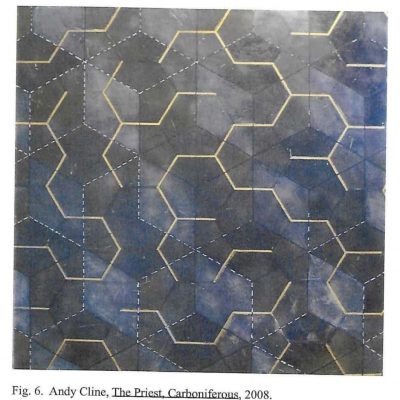
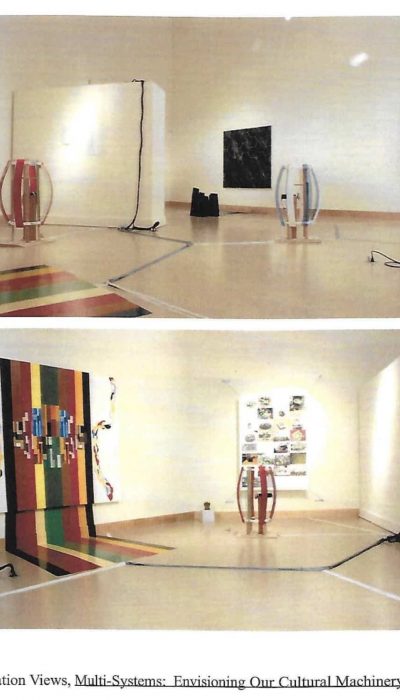
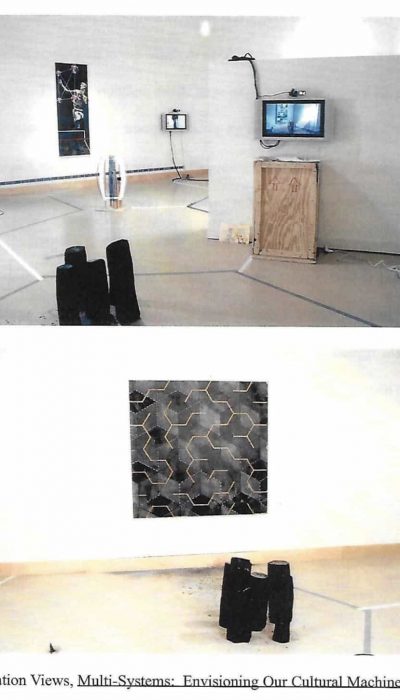
CONCLUSION
Multi-systems and the multiplex exhibition is a play with many players, each player contributing something to the whole to open up new possibilities for navigating the gallery experience. Though countless artists have engaged in conceptual art practices and have aligned themselves with the traditions rising up through Tzara, Dada, Duchamp, Fluxus and Pop Art, the public’s orientation to a more experimental and intellectual aesthetic is still developing.
In a world that seems to be steadily starved for community and goodwill, I maintain a motion to create passage and conductivity. As we move into
an increasing cyborg world, artists have a responsibility to find ways to interpret new mediums creatively, thereby providing new human possibilities for their use.
We must keep moving forward into the future. Media will change, along with fashion and cognition. All is in flux. But we owe it to ourselves to maintain human dignity and to foster the development of a rich and rewarding species life, alongside all of the exciting technological advancements to come.
Multi-systems are a way of extending the analogy of ecology into the commerce of the art world and beyond.
